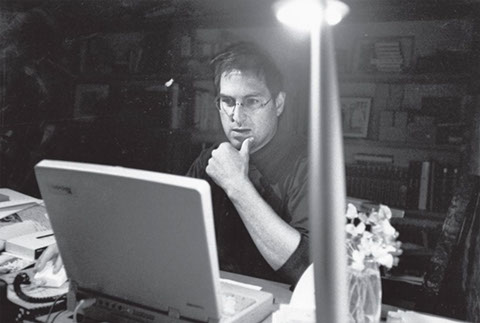The Man Behind the Mac
By Paul Sunukjian

Karen Blumenthal
Karen Blumenthal is the author of books such as Steve Jobs The Man Who Thought Different, Tommy: The Gun that Changed America, Bootleg: Murder, Moonshine, and The lawless Years of the Prohibition, and many more historical nonfiction books.





“Showman. Artist. Tyrant. Genius. Jerk.”, all words used to describe Steve Jobs, one of the most influential minds of the computer revolution¹. In her book Steve Jobs The Man Who Thought Different, Karen Blumenthal explores the man who made the computer age and how he grew up, how he shaped the growth of the computer revolution, and how he died.
The book begins with a brief account of how Steve Jobs came to his parents. Jobs was the result of an unmarried college girl’s unplanned pregnancy and given the societal implications of the time, he was given up by his birth mother. Clara and Paul Jobs adopted Jobs on the condition that he would go to college when he grew up. Steve’s father was a mechanic and taught him about tools and working with his hands, contributing to his curiosity as a child. Steve was described as a difficult child to raise and an even more difficult and disagreeable student. Even in his early childhood through the hijinx and mischievous pranks it was obvious that Steve was a genius. In elementary school Jobs “tested and scored so high that school officials recommended he skip a couple grades”.² Steve eventually met Stephen Gary Wozniak, a neighborhood kid a few years older than Steve, and the two quickly became friends. As the two grew they became more and more interested in technology and together started their first “business”. Jobs and Wozniak had discovered a way to make free phone calls to and from anywhere in the world using a device they called the “blue box”. The machine emitted a frequency that allowed them to get past telephone companies and operators. These boxes were a hit and, although they were illegal, Jobs and Wozniak sold them for huge profits to their classmates. When the time came for Jobs to go to college, his parents held true to their promise and sent him to Reed College. While at Reed, Jobs quickly learned that college was not for him. Jobs felt like the college was making him take too many courses and he ended up dropping out after his first semester. After Steve dropped out of college he spent some time on campus living with friends eventually returned home to start the next chapter of his life.
At this point the book shifts to focus on Jobs’ career and his growth in the field of technology. Jobs got a job with Atari and quickly rose through the ranks until he was sent to Germany to help fix a technological problem that no one else there could fix. After the problem was resolved, Jobs decided to follow his dreams and went to India with a friend and spent time traveling before he realized the extent of poverty and suffering in India. After he returned home, he was a changed man. Once back in the United States, Jobs reunited with Wozniak, who pitched him the idea of a personal computer. After scrounging enough money together to build a prototype, Jobs went looking for customers. Paul Terrell, owner of a local tech store, offered Jobs the dream deal, a contract for fifty computers for twenty-five-thousand dollars. With an order ready Jobs and Wozniak needed money to buy the parts and employees to build the computers. No banks or companies would give them the loans so Jobs and Wozniak went to their friends and family in search of money. Eventually they got enough to buy off brand parts which they assembled with the help of their families in their garage. The computers sold and Apple began to grow attracting the interest of Mike Markkula, a millionaire who worked for Intel before he retired on his investments. Markkula recognized the potential of Apple and predicted “This is the start of an industry” and that “the company would make the Fortune 500”.³ With Markkula and his money on board Apple began to grow even faster and more people joined.
At this point the book shifts away from Jobs and his life and more into the various products Apple put out and the innovations it made thanks to Wozniak’s brilliant circuitry and coding. Jobs, now a big shot in the computer world, met with the owners of Xerox who showed him something that would change the way computers worked forever. Jobs saw that Xerox had created a GUI (Graphic User Interface) that looked like file folders and could be opened and contained computer files and word documents like the files we use today. This led Apple to the Lisa Project, a computer for the office, but at this point Jobs was little more than a figurehead at Apple and was unable to work on the project and turned his attention to something even more revolutionary. Jobs took interest in the computer project dubbed “Macintosh” a simpler computer that was affordable to the consumer and made it his pet project. Jobs obsessed over every detail and pushed the designers and engineers to find perfection. Jobs had a passion for simplicity saying “Simplicity is the ultimate sophistication”⁴ and although it seemed like just a preference back then, it is one of the things that made Apple so different from it competition. Before the Macintosh was finished IBM released its computer which sold well among businesses and large corporations worrying Jobs. It was at this point that Jobs met Bill Gates. Gates and Jobs had nearly opposite views on what a computer should be. Jobs saw computers as tools for the individual to better their lives while Gates saw computers as something more broad and less personal. Gates saw computers as a way for companies to network and for people to communicate and calculate with. Within a few years, however, things began to look bad for Apple. Gates had been right and IBM’s computers began to outsell Apple. To make matters worse, IBM and other computer creators all used the same software created by Microsoft. When the Macintosh finally came out things were disastrous for Apple. The computer had limited memory, overheated easily, was almost impossible to customise, and didn’t run the same software as other PC’s or even other Apple products. It was after this and a series of other financial problems that Jobs was removed from Apple. After leaving Apple Jobs created NeXT with himself at the head and no meddling board of executives to get in his way. NeXT and Jobs release computers and software that were amazing for the time but they still had some drawbacks. While the computers were amazing they came at a price and this price meant that many consumers couldn’t afford one and the computer itself wasn’t compatible with any other software brand meaning even if you could afford the computer you had to pay even more for the operating system. Still struggling with his new company, Jobs had a new problem, his girlfriend was pregnant. In 1991, Jobs finally made a decision that changed him from the brash, impulsive young kid he was to a grown adult: he married Laurene Powell. This life change also marked the beginning of a business change for Jobs and his return to Apple.
As the book comes to a close the author writes about the rise of the Apple we know today and about what made Jobs different, and ultimately, his death. In 1997 the current CEO of Apple, Gil Amelio, was removed and Jobs took his place; afterwards, he began to run Apple not as the impulsive young man he once was but as an adult and as a father. Apple still needed help because with Jobs away at NeXT, Apple had been surpassed by many other computer companies also; with the threat of Microsoft no longer making compatible software Apple risked complete failure. Jobs made a deal with Bill Gates to settle disputes over patents in exchange for an agreement to continue writing software for Apple products. With his software secured, Jobs still needed to sell his products. Jobs’ first step in doing this was reworking the marketing strategy. Apple’s new slogan “Think Different” fit what Jobs wanted, it didn’t focus on what the products were, it focused on what the company was about, about being different. Jobs even chose to use different instead of differently even though it was grammatically incorrect to reinforce the idea that it wasn’t about how to think but “what to think about”⁵. In 1997 Apple finally began to turn around with Jobs at its head working for literally one dollar a year to prove that it wasn’t about the money for him, it was about the good he was doing and the change he was creating. Apple was still growing but it really blew up with the rise of the mobile music industry. Until then portable music devices were limited by having a small memory and short battery life. Jobs revolutionized this with the release of the iPod which gave birth to the Apple products and style we know today. With the huge success of Apple came the fall of a legend. In 2003 Jobs was diagnosed with pancreatic cancer but instead of having the surgery to remove the tumor Jobs fell back to his vegan diet and herbal remedies to save him. It wasn’t for another year in 2004 that Jobs finally agreed to have the surgery. In the last years of his life Jobs strived to leave behind as much good as he could. Jobs worked in a frenzy pushing design teams and engineers to make every product perfect. One of the most important legacies he left behind at Apple was the idea to keep things as simple as possible.
The author, Karen Blumenthal, used this book as a window into the past allowing the reader to get to know Steve Jobs as more than a businessman, but as a person, and as a revolutionary. Blumenthal wanted to show Jobs as he really was “Showman. Artist. Tyrant. Genius. Jerk.”⁶ Jobs was one of the most important figures in the birth and creation of the computer revolution and it is important to know about the man behind the company that started it all. Additionally, by showing the most personal things about Jobs, Blumenthal shows the public what kind of man Jobs was and how he made what is today one of the biggest companies in the world.
Karen Blumenthal is journalist that writes nonfiction books for young people and focuses on social changes and why they happen. Karen grew up as a self proclaimed nerd, something that probably drew her to Steve Jobs. One of Karen’s other books, Bootleg: Murder, Moonshine, and the Lawless Years of Prohibition also focuses on the Prohibition era and the changes it caused in the United States. Her biography on Steve Jobs is more focused but shows how much one person can change the world. The book, written and published in 2012, is fairly recent and allows the reader a view of Steve Job’s life in its entirety, something an older book would have been unable to accomplish. This is especially important as it also lets the reader see the legacy Jobs left behind: “Only a few business icons in history changed a single industry, but Jobs remade several.”⁷ With Apple still a monumental force today it is important to keep in mind its humble origins and the way it changed not just computers but society as a whole.
The reviews for Steve Jobs: The Man Who Thought Different were overwhelmingly positive. Pamela Parker calls the book “a remarkable feet, honestly” and compares it to other biographies about Steve Jobs and his growth in Apple⁸. Parker says that the book is only about one tenth as long as Walter Isaacson’s biography while remaining complete and feeling whole. Another strong point Parker highlights is how well Karen Blumenthal weaves together the various and very different parts of Steve Jobs’ life. It was this combination of different stages of Jobs’ that Parker accounts for making the book so cohesive and readable. She also commends Blumenthal for her lack of restraint when talking about Job’s various flaws and the many quarks that made him who he was as a person. Parker even says that although this was written as a novel for young teens it offers and inspiring story of a real life modern day superhero who fights against the established norm and creates his own world.
Another review by Kirkus Reviews did not praise the book as strongly, but still liked and recommended the book. This review, like Parker’s, commends the way Blumenthal weaves together Jobs’ many life experiences and writes “Despite getting bogged down occasionally in detail, the author tells a cohesive tale, infused with dry wit.” Kirkus also comments more on how well researched the book was and how accurately Blumenthal records “the subject’s foibles as well as his genius.”⁹ Opposite to Parker’s review however, this review condemns the book as being not adultery enough which may just have been a perspective difference based on the target audience. As Parker said for a young adult novel, the book was remarkably high brow while Kirkus may be judging the book relative to all other biographies and not as a young adult novel.
With the bias of a young teen, this book balanced just the right amount of advanced ideas and adult writing to balance with some of the more childish moments and events. Blumenthal also did an exceptional job of recapping the total sum of a man’s life, without becoming boring or feeling monotonous. She did this using many techniques but the one that was most greatly appreciated was her use of, as Kirkus called it, dry wit. One example of this was shortly after Jobs was fired from Apple, Blumenthal writes, “He also considered going into politics, but he had never actually voted, which would have been a drawback”¹⁰ or later when she describes his way of relaxing by dipping his feet in a toilet and flushing. One of the other notable things not mentioned in either review is how the book did not feel like a history book about a man’s life, but read like a narrative, a story of a boy who worked hard and despite adversity grew up to revolutionize and define the computer industry.
Like most biographies, this book wasn’t written with any one part of Jobs’ life in mind but focused more on his life as a whole and how it affected the world. The author didn’t focus on the 70s as time period but wrote extensively in the first half of the book on Jobs’ life and actions during that period and how those actions “would also change the world.”¹¹ For example, his work in his garage with Wozniak and their creation of the Apple I and Apple II planted the seeds that grew into the tree that Apple is today and shaped the technology of the 1970s.
Using detailed events and the story of an interesting and inspiring individual Karen Blumenthal creates an pleasing read that explains the life and mind of one of the greatest minds of the information age. Blumenthal and Jobs alike “Followed his heart. He didn’t settle for okay.” ¹²
Footnotes:
1.Blumenthal, Karen. Steve Jobs the Man Who Thought Different: 2012. Great Britian: Bloomsbury Publishing Plc. 3
2.Blumenthal, Karen. 13
3.Blumenthal, Karen. 53
4.Blumenthal, Karen. 78
5.Blumenthal, Karen. 110
6.Blumenthal, Karen. 192
7. Blumenthal, Karen 265
8.Parker, Pamela. "TEEN SCENE: Steve Jobs: The Man Who Thought Different by Karen Blumenthal." TEEN SCENE: Steve Jobs: The Man Who Thought Different by Karen Blumenthal. Teen Scene, 6 Nov. 2013. Web. 29 May 2015.
9. "STEVE JOBS by Karen Blumenthal | Kirkus." Kirkus Reviews. Kirkus Review, 5 Feb. 2012. Web. 29 May 2015.
10. Blumenthal, Karen. Steve Jobs the Man Who Thought Different: 2012. Great Britian: Bloomsbury Publishing Plc. 213
11. Blumenthal, Karen. Steve Jobs the Man Who Thought Different: 2012. Great Britian: Bloomsbury Publishing Plc. 2
12. Blumenthal, Karen. Steve Jobs the Man Who Thought Different: 2012. Great Britian: Bloomsbury Publishing Plc. 267



3 - 3
<
>